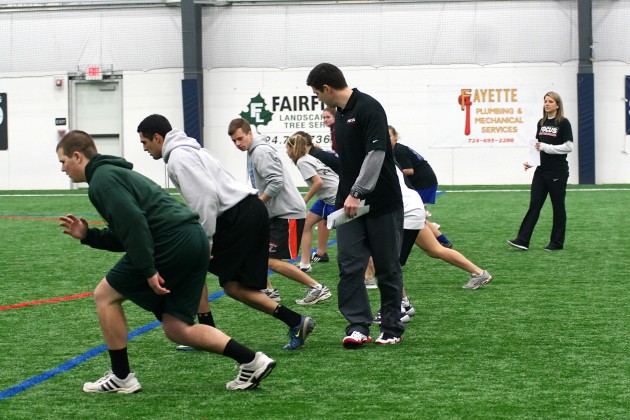6 Superior Baseball Conditioning Routines
No matter what sport you play, at some point in your athletic career you will run. Long distance, sprints, intervals, gassers, suicides—you name it, you will run it.
Today, coaches of many sports incorporate the aforementioned conditioning variations; but unfortunately, baseball coaches tend to stick with traditional long distance running. In my opinion, this isn’t a useful form of conditioning for baseball players. (See Does Running Build Muscle? )
Baseball is a power sport in which most action on the field occurs quickly, with bursts of acceleration and top speed followed by long periods of rest. (Read more on STACK’s Baseball page.) So when considering conditioning for baseball, coaches should look to mimic the demands of the sport. Incorporating long distance running doesn’t come close. In a long distance run, an athlete exerts himself at moderate intensity over a long duration, thereby training his body to operate at a slower pace. The human body is very efficient at adapting to the environment it is placed in. The cliché train slow be slow, train fast be fast rings true here.
If you want to be quick and explosive, your conditioning needs to involve sprint work, sled pushes, medicine ball circuits and other power movements. Don’t forget about rest intervals either. In a sport where you can achieve nearly full recovery before you make another pitch, take another swing, or advance to the next base, you should be taking adequate rest between bouts of sprints or other conditioning sets.
Here are six sample baseball conditioning routines you can try.
Sprints at Various Distances
This is just basic sprint work. Use the foul line as your starting point and set up cones at distances of 20, 40 and 60 yards. Complete sprints at those distances as follows:
- 2 20-yard sprints at 75% effort
- 2 40-yard sprints at full effort
- 2 60-yard sprints at full effort
- 2 40-yard sprints at full effort
- 2 20-yard sprints at full effort
Walk back to the starting line after completing each sprint. The walk back is your rest and should give you sufficient time to recover before the next sprint. When you return to the line, start your next sprint.
Build-Up Sprints or Flying Starts
Build-up sprints (or Flying Starts) begin with the athlete already in motion. In the example below, you will run a total of 60 yards, but only the second 30 yards at full speed. Again, use the foul line as your starting point. Set up cones at 30 and 60 yards. Perform a couple of light sprints first. When you perform the Build-Up sprints, begin your run at 50 to 75% effort. As you hit the halfway mark, increase your speed to 100% effort.
- 2 30-yard sprints at 50% effort
- 8 60-yard Build-Up sprints: first 30 yards at 75% effort, second 30 yards at 100% effort
Again, after each sprint, use your walk back to the starting line as your rest.
Base Running Drills
Talk about getting sport-specific. Base running drills allow you to work on your base running skills while also working on your conditioning. Try this sequence:
- Start at home. Sprint through 1st base. Walk to 2nd base.
- Get your normal lead from 2nd base and sprint home as if trying to score on a single. After reaching home, walk to 1st base.
- Get your lead from 1st base and sprint to 3rd base. Walk to home.
- Starting at home plate, sprint to second as if you just hit a double. Walk to 3rd base.
- Again, take your normal lead from 3rd base and sprint home as if you were trying to score on a grounder to the infield. Walk to 1st base.
- Take your lead from 1st base and sprint around the bases to score at home.
Rest to full recovery after one full set of the above sequence. Perform one to three sets.
Shuttle Runs
Shuttle runs allow you to work on agility and change of direction. Set up two cones anywhere from 10 to 20 yards apart. Begin at the start cone and sprint full speed to the second cone. Decelerate and change direction, then sprint back to the start. Performing the total assigned distance between the cones completes one rep. Here’s a good series where the total distance may is similar from rep to rep, but the distance between the cones varies, allowing for more or less change of direction.
- 2 x 30 yards – cones 10 yards apart
- 2 x 60 yards – cones 15 yards apart
- 2 x 60 yards – cones 20 yards apart
- 2 x 60 yards – cones 10 yards apart
Rest one to two minutes between sets.
Sled Pushes
Sled pushes are great for working on leg drive. You can load the sled with heavy weight and really work on your leg strength, or you can go lighter and work on pure speed. Either way, you are going to be challenged. Depending on your current level of conditioning, shoot for three to six sets of 30 yards per push. Check out the video at the top.
Lateral Sled Drag
Similar to sled pushes, except now you get to work laterally. Hook up a rope, TRX strap or other handles to the sled. Turn sideways and hold the handle with one hand. Begin by bringing your trail leg in front of your body and driving it back through the ground to move laterally. Aim for three to six sets of 20 yards each direction.
(video by Cressey Performance)
RECOMMENDED FOR YOU
MOST POPULAR
6 Superior Baseball Conditioning Routines
No matter what sport you play, at some point in your athletic career you will run. Long distance, sprints, intervals, gassers, suicides—you name it, you will run it.
Today, coaches of many sports incorporate the aforementioned conditioning variations; but unfortunately, baseball coaches tend to stick with traditional long distance running. In my opinion, this isn’t a useful form of conditioning for baseball players. (See Does Running Build Muscle? )
Baseball is a power sport in which most action on the field occurs quickly, with bursts of acceleration and top speed followed by long periods of rest. (Read more on STACK’s Baseball page.) So when considering conditioning for baseball, coaches should look to mimic the demands of the sport. Incorporating long distance running doesn’t come close. In a long distance run, an athlete exerts himself at moderate intensity over a long duration, thereby training his body to operate at a slower pace. The human body is very efficient at adapting to the environment it is placed in. The cliché train slow be slow, train fast be fast rings true here.
If you want to be quick and explosive, your conditioning needs to involve sprint work, sled pushes, medicine ball circuits and other power movements. Don’t forget about rest intervals either. In a sport where you can achieve nearly full recovery before you make another pitch, take another swing, or advance to the next base, you should be taking adequate rest between bouts of sprints or other conditioning sets.
Here are six sample baseball conditioning routines you can try.
Sprints at Various Distances
This is just basic sprint work. Use the foul line as your starting point and set up cones at distances of 20, 40 and 60 yards. Complete sprints at those distances as follows:
- 2 20-yard sprints at 75% effort
- 2 40-yard sprints at full effort
- 2 60-yard sprints at full effort
- 2 40-yard sprints at full effort
- 2 20-yard sprints at full effort
Walk back to the starting line after completing each sprint. The walk back is your rest and should give you sufficient time to recover before the next sprint. When you return to the line, start your next sprint.
Build-Up Sprints or Flying Starts
Build-up sprints (or Flying Starts) begin with the athlete already in motion. In the example below, you will run a total of 60 yards, but only the second 30 yards at full speed. Again, use the foul line as your starting point. Set up cones at 30 and 60 yards. Perform a couple of light sprints first. When you perform the Build-Up sprints, begin your run at 50 to 75% effort. As you hit the halfway mark, increase your speed to 100% effort.
- 2 30-yard sprints at 50% effort
- 8 60-yard Build-Up sprints: first 30 yards at 75% effort, second 30 yards at 100% effort
Again, after each sprint, use your walk back to the starting line as your rest.
Base Running Drills
Talk about getting sport-specific. Base running drills allow you to work on your base running skills while also working on your conditioning. Try this sequence:
- Start at home. Sprint through 1st base. Walk to 2nd base.
- Get your normal lead from 2nd base and sprint home as if trying to score on a single. After reaching home, walk to 1st base.
- Get your lead from 1st base and sprint to 3rd base. Walk to home.
- Starting at home plate, sprint to second as if you just hit a double. Walk to 3rd base.
- Again, take your normal lead from 3rd base and sprint home as if you were trying to score on a grounder to the infield. Walk to 1st base.
- Take your lead from 1st base and sprint around the bases to score at home.
Rest to full recovery after one full set of the above sequence. Perform one to three sets.
Shuttle Runs
Shuttle runs allow you to work on agility and change of direction. Set up two cones anywhere from 10 to 20 yards apart. Begin at the start cone and sprint full speed to the second cone. Decelerate and change direction, then sprint back to the start. Performing the total assigned distance between the cones completes one rep. Here’s a good series where the total distance may is similar from rep to rep, but the distance between the cones varies, allowing for more or less change of direction.
- 2 x 30 yards – cones 10 yards apart
- 2 x 60 yards – cones 15 yards apart
- 2 x 60 yards – cones 20 yards apart
- 2 x 60 yards – cones 10 yards apart
Rest one to two minutes between sets.
Sled Pushes
Sled pushes are great for working on leg drive. You can load the sled with heavy weight and really work on your leg strength, or you can go lighter and work on pure speed. Either way, you are going to be challenged. Depending on your current level of conditioning, shoot for three to six sets of 30 yards per push. Check out the video at the top.
Lateral Sled Drag
Similar to sled pushes, except now you get to work laterally. Hook up a rope, TRX strap or other handles to the sled. Turn sideways and hold the handle with one hand. Begin by bringing your trail leg in front of your body and driving it back through the ground to move laterally. Aim for three to six sets of 20 yards each direction.
[youtube video=”bTlQkXHtfdo” /](video by Cressey Performance)











